Apr
24th
Stay connected Subscribe to our RSS feed
TORONTO, Ont. -- When Ford introduced the Mustang 50 years ago, it was the beginning of an enduring and much-loved cultural icon. To celebrate the birthday of this legendary pony car, more than 125 members of the Golden Horseshoe Mustang Association and GTA Mustang Club gathered at Ontario Place, and 25 classic Mustangs formed a giant "50" for a commemorative aerial shot.
When the Mustang arrived in 1964, it created a new segment: the pony car.
Small, economical and with a modicum of practicality, the Mustang was a new type of muscle car, an attainable one, a sports car for the masses.
Of all the competing pony cars that followed in its wake, the Mustang was the only one that continued production -- uninterrupted, until this day. Undeterred by the fuel crises and emissions restrictions of the ‘70s and, later on, company budget cuts the Mustang's popularity with legions of fans enabled it to soldier on through the tough years. Models such as the late ‘60's Shelby, the 1970 Boss Mustang, the Mach I and II and later on, the SVT Cobras all earned iconic status as collector cars.
However, the cars that cemented its place in the annals of automotive history were the humble runabouts. While Ford's then GM, Lee Iacocca would have loved to produce a hot two-seater sports car he was wise enough to realize that the Mustang's success depended on volume sales.
There was absolutely nothing exotic about the Mustang -- in fact, quite the opposite. Assembled by the people, for the people, the original pony travelled the same production line and shared parts with such run-of-the-mill family cars as the Falcon and Galaxy -- but therein lays its appeal.
The introduction of the Mustang at the 1964 New York World's Fair coincided with the beginning of the Boomer generation's coming of age. While its unibody structure shared the same underpinnings as the Falcon, the long hood, short deck and grille-mounted pony badge were an instant hit during a time when youth were celebrating a new freedom. And at roughly $2,400 for a 6-cylinder notchback coupe, the Mustang was economically within reach for a lot of people.
Fewer than 560,000 Mustangs were sold that first year to an infatuated public whose enthusiasm showed no signs of waning. However, with such mundane underpinnings, they were far more show than go, and the original pony cars were little more than attractive family runabouts. There were several available engines, the base was an anemic 2.8L straight-6 with only 101 hp, and the most powerful was a "K-code" 4.7L V8 with 271 hp.
Ford enlisted the help of Carroll Shelby -- the Texas racer whose name became synonymous with Ford performance -- to create a Mustang worthy of the racetrack. To comply with homologation rules, Shelby took 100 2+2 fastback coupes and transformed them into the GT 350 -- a modified two-seater with 306 hp (360 hp for racing versions) special suspension, performance brakes, and fiberglass hoods.
Over the next few years, the Mustang grew larger and more powerful in response to new rivals in the segment it had created. With the arrival of the Chevrolet Camaro, Pontiac Firebird, and Plymouth's Barracuda, the pony car wars had begun.
By 1969, the Mustang became a rather large pony. Design changes included four headlights on the long nose and sheet metal that was scalloped with fake scoops and inlets. The legendary Boss 302, designed to compete in the Trans Am road racing series, was introduced
By the time the second generation rolled out in 1974, it had grown too large to be considered a real pony car and its less than distinctive appearance never really resonated with Mustang lovers. By then, it had fallen victim to the triple-headed sword of tough emissions regulations, the fuel crisis, and higher insurance rates. Power output was dropped to 88 hp for the base six, and topped out with a paltry 150 hp in the V8s.
If the second generation Mustang was a disappointment, the third goes down in history as one of the worst cars ever made. Re-engineered to compete with the arrival of compact, fuel-efficient Japanese cars, the "Mustang II" featured an unremarkable design on top of a Pinto body. For the first time, the Mustang was available with a 4-cylinder engine and no V8. Yet, as mediocre as the Mustang II was, it sold extremely well and its success helped Ford through those tough years.
The third generation "Fox" body Mustangs enjoyed 15 years of success, although its square, compact shape in no way resembled the original pony.
By 1994, Ford decided a refresh was in order, and a new body style harkening back to the Mustang's roots was introduced. The fuel crises of the ‘70s long past, it later featured several high-performance versions, including a "Cobra," "Bullitt" and "Mach I."
However, it was the fifth generation -- introduced in 2005 -- that captured the public's hearts with its retro design that so clearly paid homage to the original. Rekindling the pony-car love was the reintroduction of such iconic nameplates as the GT 500 and Boss 302.
With a brand new, sixth-generation model due to arrive this fall, the Mustang celebrates 50 years of uninterrupted success.
When the Mustang arrived in 1964, it created a new segment: the pony car.
Small, economical and with a modicum of practicality, the Mustang was a new type of muscle car, an attainable one, a sports car for the masses.
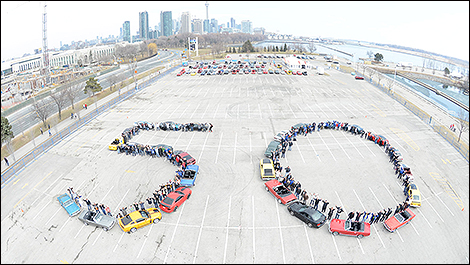 |
| Photo: Lesley Wimbush |
Of all the competing pony cars that followed in its wake, the Mustang was the only one that continued production -- uninterrupted, until this day. Undeterred by the fuel crises and emissions restrictions of the ‘70s and, later on, company budget cuts the Mustang's popularity with legions of fans enabled it to soldier on through the tough years. Models such as the late ‘60's Shelby, the 1970 Boss Mustang, the Mach I and II and later on, the SVT Cobras all earned iconic status as collector cars.
However, the cars that cemented its place in the annals of automotive history were the humble runabouts. While Ford's then GM, Lee Iacocca would have loved to produce a hot two-seater sports car he was wise enough to realize that the Mustang's success depended on volume sales.
There was absolutely nothing exotic about the Mustang -- in fact, quite the opposite. Assembled by the people, for the people, the original pony travelled the same production line and shared parts with such run-of-the-mill family cars as the Falcon and Galaxy -- but therein lays its appeal.
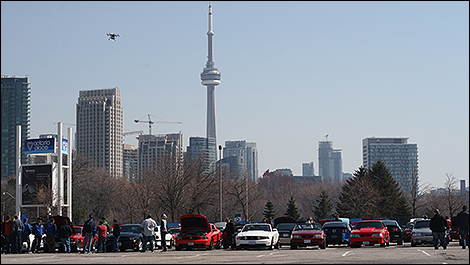 |
| Photo: Lesley Wimbush |
The introduction of the Mustang at the 1964 New York World's Fair coincided with the beginning of the Boomer generation's coming of age. While its unibody structure shared the same underpinnings as the Falcon, the long hood, short deck and grille-mounted pony badge were an instant hit during a time when youth were celebrating a new freedom. And at roughly $2,400 for a 6-cylinder notchback coupe, the Mustang was economically within reach for a lot of people.
Fewer than 560,000 Mustangs were sold that first year to an infatuated public whose enthusiasm showed no signs of waning. However, with such mundane underpinnings, they were far more show than go, and the original pony cars were little more than attractive family runabouts. There were several available engines, the base was an anemic 2.8L straight-6 with only 101 hp, and the most powerful was a "K-code" 4.7L V8 with 271 hp.
Ford enlisted the help of Carroll Shelby -- the Texas racer whose name became synonymous with Ford performance -- to create a Mustang worthy of the racetrack. To comply with homologation rules, Shelby took 100 2+2 fastback coupes and transformed them into the GT 350 -- a modified two-seater with 306 hp (360 hp for racing versions) special suspension, performance brakes, and fiberglass hoods.
Over the next few years, the Mustang grew larger and more powerful in response to new rivals in the segment it had created. With the arrival of the Chevrolet Camaro, Pontiac Firebird, and Plymouth's Barracuda, the pony car wars had begun.
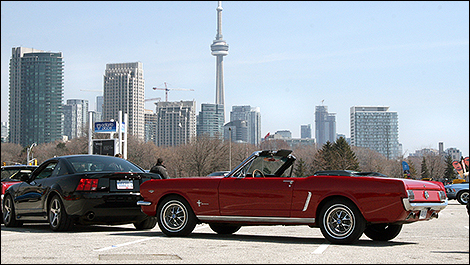 |
| Photo: Lesley Wimbush |
By 1969, the Mustang became a rather large pony. Design changes included four headlights on the long nose and sheet metal that was scalloped with fake scoops and inlets. The legendary Boss 302, designed to compete in the Trans Am road racing series, was introduced
By the time the second generation rolled out in 1974, it had grown too large to be considered a real pony car and its less than distinctive appearance never really resonated with Mustang lovers. By then, it had fallen victim to the triple-headed sword of tough emissions regulations, the fuel crisis, and higher insurance rates. Power output was dropped to 88 hp for the base six, and topped out with a paltry 150 hp in the V8s.
If the second generation Mustang was a disappointment, the third goes down in history as one of the worst cars ever made. Re-engineered to compete with the arrival of compact, fuel-efficient Japanese cars, the "Mustang II" featured an unremarkable design on top of a Pinto body. For the first time, the Mustang was available with a 4-cylinder engine and no V8. Yet, as mediocre as the Mustang II was, it sold extremely well and its success helped Ford through those tough years.
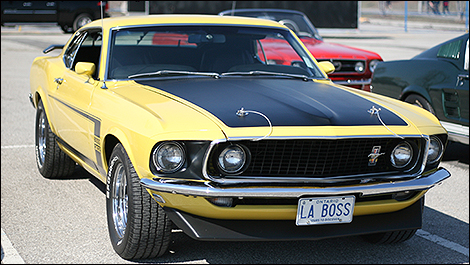 |
| Photo: Lesley Wimbush |
The third generation "Fox" body Mustangs enjoyed 15 years of success, although its square, compact shape in no way resembled the original pony.
By 1994, Ford decided a refresh was in order, and a new body style harkening back to the Mustang's roots was introduced. The fuel crises of the ‘70s long past, it later featured several high-performance versions, including a "Cobra," "Bullitt" and "Mach I."
However, it was the fifth generation -- introduced in 2005 -- that captured the public's hearts with its retro design that so clearly paid homage to the original. Rekindling the pony-car love was the reintroduction of such iconic nameplates as the GT 500 and Boss 302.
With a brand new, sixth-generation model due to arrive this fall, the Mustang celebrates 50 years of uninterrupted success.
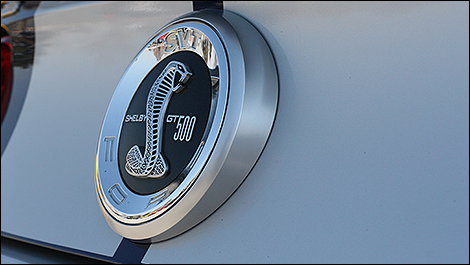 |
| Photo: Lesley Wimbush |
 The latest auto news, reviews, prices, product and vehicle releases.
The latest auto news, reviews, prices, product and vehicle releases.